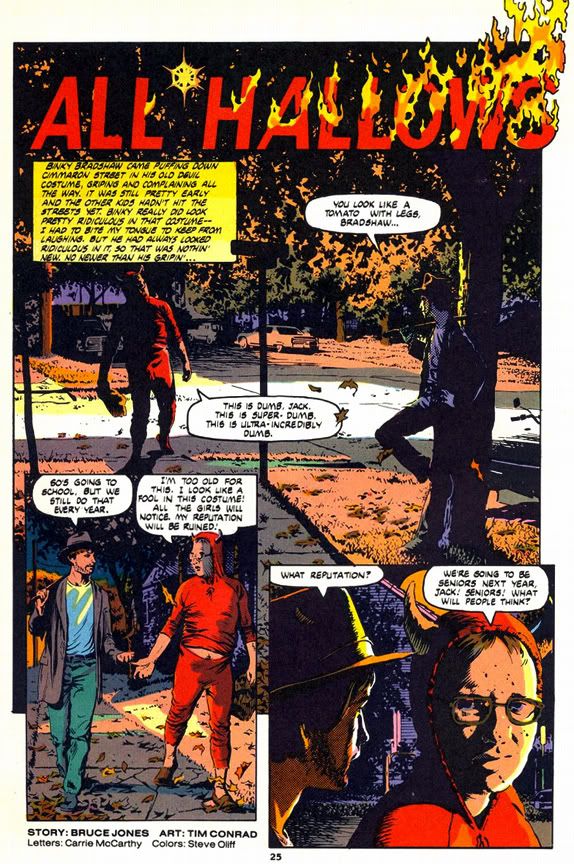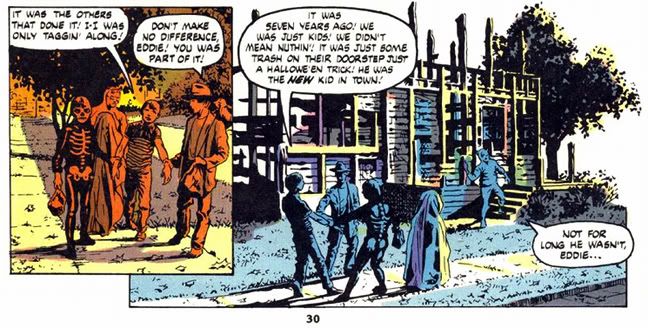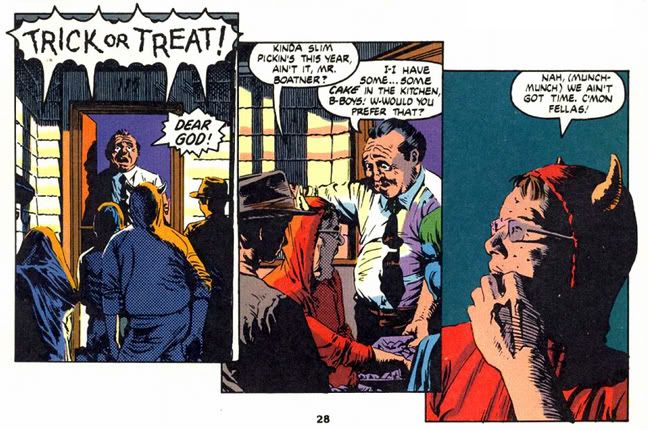 Back in the old days, before any of you were born, there suddenly appeared these new upstart, upscale comic book companies with names like First, Aardvark-Vanaheim and Pacific. Pacific printed their comics—which were pricey for the times at $1.50 a pop—on state-of-the-art Baxter paper. What is Baxter paper?
Back in the old days, before any of you were born, there suddenly appeared these new upstart, upscale comic book companies with names like First, Aardvark-Vanaheim and Pacific. Pacific printed their comics—which were pricey for the times at $1.50 a pop—on state-of-the-art Baxter paper. What is Baxter paper?I didn’t know then, and and I don’t know now. I only know it was whiter than newsprint and made the comics printed on it look better than their shabby convenience store-dwelling cousins.
It was probably during this time I first began to drift away from the mainstream; thanks to the husband-wife owners of our local comic book store, I learned about books like American Flagg!, E-Man, Groo the Wanderer, Elric of Melnibone and… when I dared… I read Pacific’s gruesome Twisted Tales, written and edited by masterful horror scribe Bruce Jones and illustrated by some of the top talent of the day—Alfredo Alcala, Mike Ploog, Richard Corben, John Bolton, Val Mayerik, Rand Holmes and even Doug “Jonny Quest” Wildey.
The stories in Twisted Tales mostly copied the old EC Comics formula, which is a pretty good source from which to swipe your story format. Lots of twist endings and poetic justice comeuppances. Every once in a while Jones would break the mold and do something truly disturbing like “Banjo Lessons,” the controversial story told in a series of flashbacks each more detailed than the last until the awful truth stands fully revealed. And my personal favorite, “Me an’ Ol’ Rex,” a bucolic tale of a dirt-stupid country boy and his pet dinosaur and the various stereotypical assholes he feeds to it, only the dinosaur turns out to be his grandfather. As Daniel Plainview might say, “There will be blood.”
And lots of it.
By the way, did he say that in the movie? Or did he just drink milkshakes?
There are gallons of blood. And lots of sex, too. EC sometimes featured some tame cheesecake, especially in their sci-fi books. Twisted Tales has boobies galore and delightful ideas such as a rotten, foul-smelling corpse screwing its murderous wife one last time before murdering her in turn. Twisted Tales is pretty heavy on the "shrewish or sluttish woman henpecks or otherwise emasculates the innocent man" trope, too. I wouldn't mention this, but there are a lot of awful women in these stories, occasionally two an issue. Why do horror and sci-fi stories, which might otherwise be charming, truck so much with that kind of demeaning junk?
That aside, one of the coolest stories is "All Hallows," from Twisted Tales #1. It opens with some high school juniors as they self-consciously set about trick-or-treating one Halloween night. One by one they gather, a devil, a hobo, a skeleton and then bitch about having to walk across town to collect their friend Skeeter.
Colorist Steve Oliff bathes the pages in autumnal hues, and Tim Conrad's art has a fun, atmospheric quality. Dark shadows and fall leaves blowing about. Using four archetypal Halloween costumes for the main characters adds to the Halloween feel. There’s almost something comical about Binky Bradshaw with his pimpled face and his chubby body squeezed into the undersized devil suit. He even plays devil’s advocate at the outset, questioning the necessity of this yearly tradition now that the boys are all in high school. But soon enough he’s stuffing his face with doughnuts and all objections are forgotten.
The comedic aspect presented by these unlikely trick-or-treaters unravels as soon as they visit the first house. The woman who answers the door proclaims her innocence. Not your usual Halloween response. In my day, the rednecks we visited didn't shriek, "Oh! Oh my God! W-what do you want of me?" as soon as we appeared; they just took potshots at us with their snub-nosed .38s.
At this point, you know something is not as it seems. The kids collect Skeeter, who waits for them by the cemetery gates. Silent beneath his ghost costume, Skeeter completes the set and the group proceeds to spook the bejeezus out of various people. One wild-eyed old man declares them to be "monsters" and berates them for terrorizing the neighborhood. At the last house, a distraught father offers up his young son Eddie to the gang. And we learn the secret. It turns out they’re not only gathering candy and cakes, but they’re also on a mission of vengeance. Seven years before, some Halloween pranksters burned down Skeeter’s house…
 And Skeeter didn’t survive. Each Halloween the boys have gone from house-to-house, visiting Skeeter's vengeance on the hapless children responsible. Now Eddie is their final victim. You might wonder why the town allows them to do this—well, apparently, someone once tried to stop them and it ended badly. Jones elaborate, but it's enough he hints at it and allows your imagination to do the rest.
And Skeeter didn’t survive. Each Halloween the boys have gone from house-to-house, visiting Skeeter's vengeance on the hapless children responsible. Now Eddie is their final victim. You might wonder why the town allows them to do this—well, apparently, someone once tried to stop them and it ended badly. Jones elaborate, but it's enough he hints at it and allows your imagination to do the rest.Beyond Skeeter's presence, the story hints at some supernatural compulsion that motivates the boys. They wear the same costumes each year, proceed according to a set route. Yet they seem so normal, and there's the hard-won acquiesence of the families which makes it all the more eerie and terrible. Eddie seems a bit young to have done anything particularly dastardly seven years before, even as a tag-along. He could only have been five years old or so. And it’d be nice to have some sort of explanation as to why the boys didn’t just kill all the jerks that first Halloween instead of drawing it out so long.
But then we wouldn’t have a story and we’d have to do without Conrad‘s drawings of Bradford bursting out of his costume and the awkward spectacle of these trick-or-treaters who should’ve long outgrown the tradition. Well, the regular one, not their own nastier sort. And we get a nice panel showing Skeeter’s face in all its rotted gory… er… glory just before the kids set fire to little Eddie in the ruins of the burned out house. It also ends on a somewhat poignant note.
All-in-all, a wicked little Halloween treat.


No comments:
Post a Comment